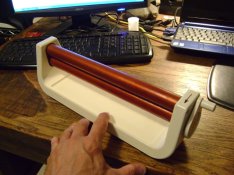ragnar58
Member
- Joined
- Feb 20, 2008
- Messages
- 28
- Format
- 35mm RF
Is it a common practice to perform an additional step between the wash and drying?
I could understand a rinse in distilled water before drying if the water is hard or if a water softener is used.
If the drying method is the back-to-back on a line, I could maybe see a wetting agent used before hanging.
Ive never seen spots from the water but wondered if anyone took an extra step at this phase.
I could understand a rinse in distilled water before drying if the water is hard or if a water softener is used.
If the drying method is the back-to-back on a line, I could maybe see a wetting agent used before hanging.
Ive never seen spots from the water but wondered if anyone took an extra step at this phase.








 ) just like toning, and another positive effect of the Sistan, it makes it easier to flatten the FB-prints after they have dried.
) just like toning, and another positive effect of the Sistan, it makes it easier to flatten the FB-prints after they have dried.


 ).
).